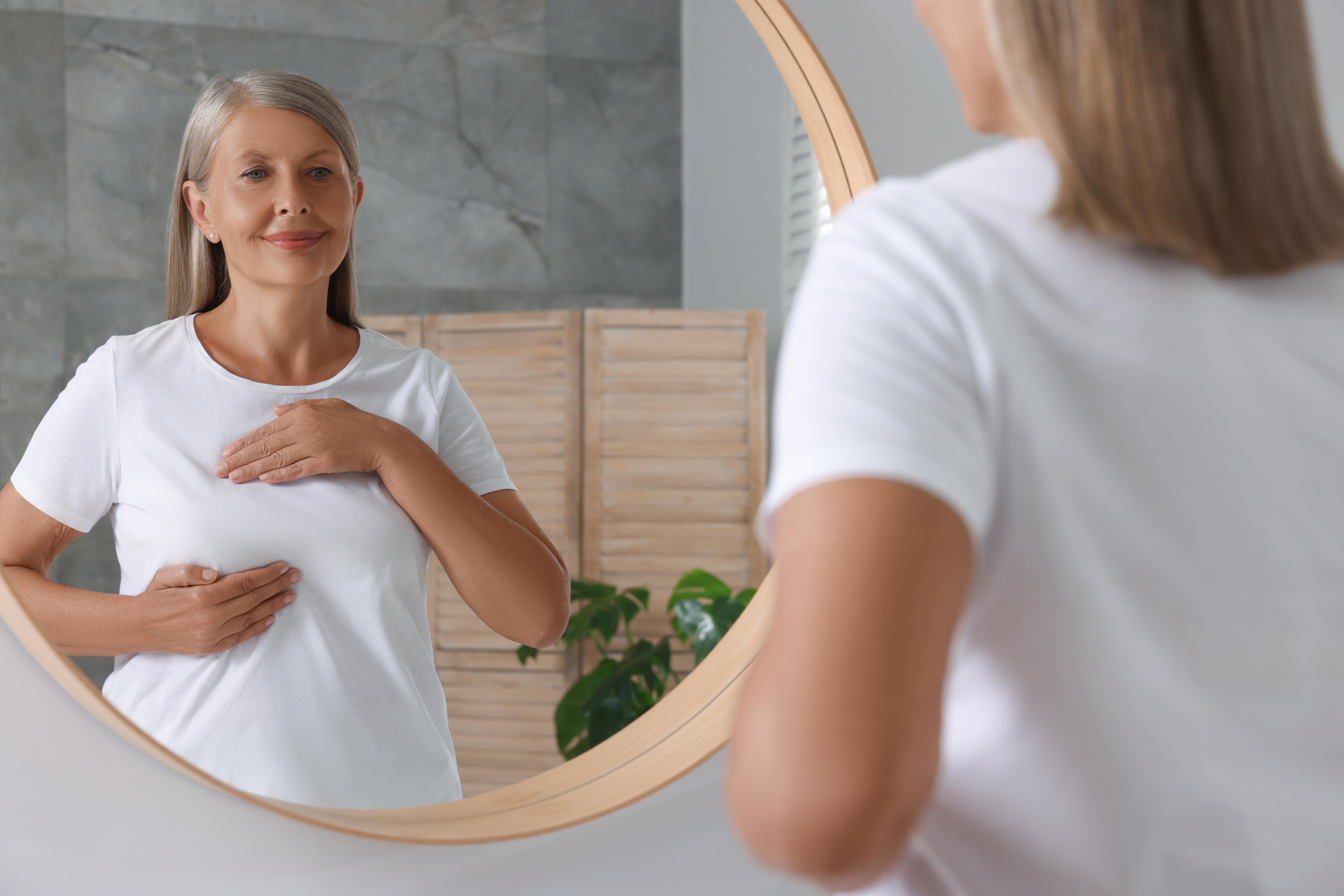Being “breast aware” is an essential step in taking charge of your breast health, and monthly breast self-exams are a key practice in achieving this. By getting to know your breasts, you’ll become familiar with their normal appearance and feel, allowing you to notice any changes more easily. Guidelines recommend that women begin performing self-exams in their 20s and continue throughout their lives as a complement to the annual clinical breast exam they receive during their well-woman visits and annual screening mammograms starting at 40.
Here’s what you should know about the importance of breast self-exams and how to perform them effectively, empowering you to take charge of your breast health year-round.
What is a Breast Self-Exam?
A breast self-exam is a personal health practice that involves checking your breasts for any unusual changes, such as lumps, size differences, nipple discharge, or skin changes, to aid in early detection of potential breast health issues, including breast cancer.
It’s a good idea to start considering breast self-exams as early as your twenties. Performed properly, they can help detect changes in the look and feel of your breasts years before your first mammogram at age 40. This is important, as the Centers for Disease Control and Prevention reports that about 1 in 10 breast cancer diagnoses occur before age 45.
Technique and Timing Matter
To make sure your monthly self-exam is as effective as possible, keep these tips in mind:
- Ask for guidance. Don’t hesitate to request a demonstration from your healthcare provider or mammogram technologist. They can show you the proper technique to make sure you’re doing it right.
- Practice makes perfect. If possible, practice your self-exam during your appointment to receive immediate feedback and make any necessary adjustments to your method.
- Stick to a schedule. Your menstrual cycle can influence how your breasts feel. For consistent results, aim to perform your breast self-exam every month between five and 10 days after your period begins.
Getting Started: Visual Inspection
Your breast self-exam should begin with a visual check. As you examine your breasts, stand in front of a mirror and look for obvious changes in your breasts’ appearance. If you have multiple mirrors, use them to view your breasts from multiple angles.
With your arms at your side, look at your breasts, paying attention to the following:
- Areola and nipple area. Seek out abnormalities in the nipple and areola. Changes to be aware of include a change in the shape of the nipple, an inverted nipple, or nipple discharge.
- Breast skin texture. Look for dimpling, puckering, or indentations in the breast, as well as skin texture that resembles an orange peel.
- Coloration. Pay attention to any rashes or redness that develops on any part of the breast.
- Overall review. Take note of any changes to the shape, size, or symmetry of your breasts.
- Movement. Once you review your breasts with your arms by your side, repeat. This time, raise your arms and extend your palms in front of yourself. Watch how the breasts move when you raise your arms and take note of any changes from one month to the next.
5 Steps for a Proper Physical Breast Self-Exam
The goal of a self-exam is to help you become more “breast aware” and familiar with the normal look and feel of your breasts, allowing you to notice any changes over time.
Here’s a step-by-step guide on how to perform a breast self-exam:
- Begin by lying on your back so that the breast tissue spreads across the chest muscles. Place a pillow under your right shoulder and your right hand behind your head.
- Starting with the right breast, use the pads of the middle fingers of your left hand, keeping your fingers together, and make a circular motion, covering the entire breast from your armpit to your cleavage and from your collarbone to the top part of your abdomen. You can begin at the nipple and work outward or move your fingers up and down in rows.
- Use light pressure for the top layer of skin and tissue just underneath, medium pressure for tissue in the middle of the breast and firm pressure for deep tissue.
- Gently squeeze the nipple to check for discharge.
- Repeat this process on the other breast and then again while standing or sitting. Some women prefer to check their breasts while in the shower.
Find Something? Contact Your Health Provider
Breast changes don’t always indicate breast cancer. For many women, breast pain, sensitivity, and lumps come and go during the menstrual cycle. That’s the power of the breast self-exam — you learn to recognize what’s normal and when a clinical breast exam or additional testing may be appropriate.
Breast changes can also be caused by outside factors, including:
- Dietary changes
- Medication side effects
- Weight changes (whether you’ve gained or lost weight)
That said, breast cancer can cause certain changes. Talk to your primary care provider or OB/GYN if you notice any of the following during your properly timed breast self-exam:
- A new lump, whether it’s a hard, painless mass or soft, round, and painful
- Breast, nipple, or underarm pain or sensitivity
- Changes in nipple or breast size or shape
- Discharge from the nipple that is watery, bloody, or milky
- Tissue growing thicker in the breast or armpit area
- Warmth, itching, or redness in the breast
Breast Self-Exams and Mammograms: A Proactive Approach
Breast self-exams are an excellent way to know your body. They familiarize you with your breasts and how they feel and look, but they are only the first step to breast awareness and a proactive approach. On their own, breast self-exams cannot visualize what’s going on beneath the skin and tell whether you have dense breast tissue. A mammogram is the only tool that can determine breast density.
Breast health experts recommend annual screening mammograms starting at age 40 for women of average risk for breast cancer. Screening mammography gives an inside look at your breasts, making this scan an excellent tool to see abnormalities your hands can’t feel and your eyes can’t see. In fact, mammograms can detect breast cancers up to three years before they can be felt. Early detection is key to diagnosing and treating breast cancers in their earliest stages.
Windsong Radiology: Your Partner in Breast Health
A small lump in your breast tissue can be unnerving. Other changes can leave you anxious and afraid. What should you do if you notice a change in your breasts during a breast self-exam? First, take a deep breath. Then, take action.
Contact your healthcare provider to discuss your findings. Your health provider may recommend a screening or diagnostic mammogram exam and evaluation by a board-certified subspecialized radiologist. Once the radiologist reviews your mammogram, they may recommend supplemental screening options with breast ultrasound or breast MRI.
These additional tests may help find answers to the questions your self-exam raises. When you’re ready, contact the experts at Windsong Radiology, and they will guide you through the next steps.







